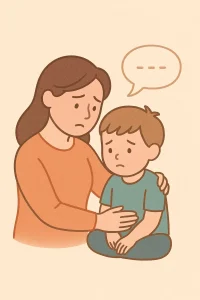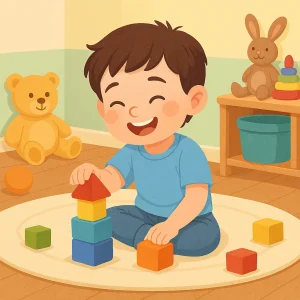8 Effective Speech Therapy Practices for Kids with Autism
By Rajini D
Last Updated: February 21, 2024
Imagine this: your child is learning to communicate, but instead of it feeling like a difficult task, it’s more like playtime filled with laughter and discovery. Speech therapy for kids with autism doesn’t have to be a chore—it can be a joyful and exciting experience. Every child deserves to express themselves, and when therapy is engaging and fun, it helps unlock their full potential.
That’s what this article is all about: exploring creative and effective speech therapy practices that not only work but also connect with the unique needs of autistic children. You’ll discover techniques that make learning to communicate feel natural and enjoyable, turning challenges into opportunities for growth. Ready to dive in? Let’s make speech therapy something your child looks forward to!
1. Animal Sound Play
Have you ever noticed how excited kids get when they hear a “meow” or a “woof”? That’s what makes Animal Sound Play such a great speech therapy tool for children with autism. It’s a fun and simple technique where you use animal toys and imitate their sounds. This approach can be especially helpful for non-verbal children because it taps into their love for animals and natural curiosity.
How It Works
Start by introducing a few animal toys, like a cat, dog, or bird. As you play, make the animal’s sound—”meow” for the cat, “woof” for the dog, or “chirp” for the bird. Then, encourage the child to listen and try to copy the sounds. It’s not about perfect pronunciation, but about having fun and getting comfortable with making sounds.
For example, you could show the child a toy duck and say, “quack, quack,” while moving the duck around. The child might smile and watch, and eventually, they may try to make their own version of a “quack.” The goal is to make it a fun game where the child feels relaxed and enjoys participating.
Also read: Play & Learn: Boost Speech with Fun Animal and Vehicle Sounds
Benefits of Animal Sound Play
This simple activity does more than just teach sounds. It helps children with autism engage and interact in a way that feels natural and fun. By mimicking animal noises, kids begin to understand the idea of communication, which can later help them with speaking.
For non-verbal children, Animal Sound Play provides a safe and enjoyable way to start using their voice. It builds their confidence in making sounds, which is an important step toward speaking.
Parents and therapists often find this method helps children take their first steps toward communication. By using something as familiar as animal sounds, you can make speech therapy feel less like work and more like play.
Read more: Animal Name Game: Fun Learning for Kids with Special Needs
2. Essential Words Learning
Moving beyond animal sounds, another effective technique in speech therapy is teaching essential words within daily routines. This involves focusing on simple yet crucial words like “more,” “help,” and “stop.” These words are fundamental to everyday communication and can significantly empower autistic children to express their needs and feelings.
Interactive Approach: The key is to incorporate these words into regular activities. For instance, during mealtime, if the child finishes their favorite dish, you could hold up more of it and say “more?” Similarly, during playtime, use toys to create scenarios where words like “help” and “stop” can be naturally introduced.
Real-Life Example: Imagine a situation where a child wants to continue playing. You can pause the play and encourage them to say “more” to resume. This method not only teaches the child essential words but also helps them understand the context in which these words are used.
Also Read: Toddler Speech Development: From Babbling To First Words
3. Favorite Toys and Gestures
Using a child’s favorite toys during speech therapy is a fun way to help them learn to communicate. This method makes playtime a chance to practice using gestures or words to ask for what they want.
How It Works
Find toys your child loves, like a favorite stuffed animal or a set of blocks. Put the toys just out of reach, so the child has to gesture or say a word to get them. For example, if they want their teddy bear, they might point to it, reach for it, or try saying “bear” or “please.” This helps them understand how communication works.
Benefits
This activity is not just fun, but it also helps children learn to express themselves. By asking for their favorite toys, they learn that using gestures or words helps them get what they want. It’s an easy way to make speech therapy part of everyday play, helping children practice communication in a way they enjoy.
4. Positive Reinforcement Strategies
Positive reinforcement is a great way to help children with autism learn during speech therapy. It means rewarding them when they do something right, which encourages them to do it again. This can be very helpful in getting children excited about learning new words and participating in therapy.
How It Works
It’s really simple. When your child says a new word or completes a speech therapy task, you give them a reward. The reward could be something they love—like extra playtime, a small treat, or even a hug or high-five. For example, if your child says “more” during snack time, you can give them more of their favorite snack as a reward.
Practical Tips for Parents
- Be Consistent: Try to reward your child every time they use a new word or complete a task. If they know they’ll get to play longer with their favorite toy after saying a word like “more,” they’ll be excited to keep practicing.
- Immediate Rewards: Give the reward right after your child does something positive. This helps them connect the reward with their progress. If they ask for “help” using the right word, praise them or give a small reward right away.
- Use Specific Praise: Instead of just saying “good job,” be specific about what they did. For example, say, “Great job saying ‘more’ when you wanted more blocks!” This makes it clear to your child what they did right.
Positive Reinforcement Rewards
| Behavior/Task Completed | Reward |
|---|---|
| Successfully saying a new word | Extra playtime with their favorite toy |
| Completing a speech therapy task | Small treat or snack |
| Using a specific word during play | Praise and encouragement |
5. Choice-Based Communication
Choice-based communication is a simple and effective way to help children with autism improve their communication skills. This approach encourages the child to make decisions and communicate their preferences by offering them choices during everyday activities.
How to Use Choice-Based Communication
Incorporating this method into daily routines is easy. For example, during snack time, instead of giving your child a pre-selected snack, offer them a choice between two options. Hold up an apple and a banana and ask, “Would you like an apple or a banana?” This allows your child to make a decision and communicate, either by using words or gestures like pointing.
Another example could be during playtime. You can offer a choice between two toys, asking, “Do you want to play with the blocks or the cars?” This not only encourages decision-making but also creates an opportunity for your child to practice communication in a fun and engaging way.
Benefits of Choice-Based Communication
This method is powerful because it gives the child control, making them feel more confident and empowered. It helps them understand that communication can be used to express their preferences, which boosts their confidence in speaking or using gestures. Additionally, choice-based communication fits seamlessly into everyday activities like meals, play, or getting dressed, so it can easily become a regular part of their day.
Sample Choice-Based Communication Scenarios
| Activity | Choices |
|---|---|
| Snack time | Offering a child a choice between an apple or a banana during snack time encourages them to communicate their preference. |
| Playtime with toys | Providing options like blocks or puzzles during playtime allows the child to make decisions and express their choice. |
| Activity selection | Allowing the child to choose between coloring or reading for their next activity fosters decision-making and communication. |
| Outdoor playtime | Presenting options such as swinging or sliding when playing outside encourages the child to communicate their desired activity. |
6. Interactive Storytelling
Storytelling is not just about reading a book; it’s a gateway to a world of interaction, expression, and understanding. Interactive storytelling is a dynamic activity that can greatly aid in speech and communication therapy for children with autism.
How to Engage in Interactive Storytelling:
- Choose a book with vivid pictures and simple sentences. As you read, point to and talk about the pictures. Encourage the child to do the same.
- Ask open-ended questions about the story and the characters. For example, “What do you think the bear is feeling?” This encourages the child to think and express their thoughts.
- Use facial expressions and gestures to make the story come alive. This not only makes the session more engaging but also teaches non-verbal communication cues.
Tips for Enhancing Engagement:
- Allow the child to choose the book. This gives them a sense of control and increases their interest in the activity.
- Take turns in telling the story. One page you read, the next page they try. It’s a fun way to encourage speech and also keeps the child engaged.
- Relate the story to real-life situations or the child’s experiences to make it more relatable and engaging.
Learn more about on Boost Kids Storytelling Skills: Engage and Educate at Home
7. Sensory Integration Activities
Sensory integration activities can be a great way to help children with autism improve their communication skills. These activities use different senses like touch, sight, sound, and even smell or taste to support learning, especially for children who have sensory processing challenges.
How Sensory Activities Help
Sensory activities make speech therapy more fun and effective by engaging the child’s senses. For example, using textured materials like soft fabrics or scented playdough during a session can help the child feel calm and focused. This can make it easier for them to participate and communicate.
For instance, if a child is feeling anxious or distracted, giving them something like a squishy ball to hold or colorful flashcards to look at can help them stay focused. These sensory tools can reduce stress and make speech therapy more enjoyable.
Practical Example
Imagine using scented playdough during speech therapy. As the child plays with the dough, you can ask them to say simple words like “roll” or “press.” The feel and smell of the playdough keep them engaged while they practice their speech in a fun way.
8. Social interaction and role play
Social interaction and role play are key tools in helping children with autism develop communication skills. By engaging in role-playing games and practicing social interactions, children can learn how to communicate more effectively in real-world situations.
Role-Playing in Practice
In role play, you can create simple scenarios that mimic everyday life. For example, set up a pretend grocery store where the child practices asking for items or a classroom where they can engage in school activities. These activities allow the child to practice speaking, listening, and responding in a safe and fun environment.
Another idea is to role-play a visit to the doctor, where the child can take turns being the doctor or the patient. This helps them practice using language in social situations and improves their understanding of how conversations work.
Effectiveness in the Real World
Role play is a powerful tool because it helps children practice real-life situations. They can learn how to start conversations, respond to others, and pick up on social cues in a stress-free setting. This practice prepares them for real-world interactions, giving them the confidence to communicate more easily with others.
Through role play, children get to experience and understand social situations in a way that feels safe and manageable. It helps build the skills they need to interact with peers, teachers, and others in their daily lives.
Conclusion
Speech therapy for kids with autism can be exciting, playful, and effective. At Wellness Hub, we believe in making therapy a joyful experience through techniques like Animal Sound Play, Essential Words Learning, and Interactive Storytelling. These fun activities engage children naturally, turning challenges into opportunities for growth. With methods like sensory integration and role play, communication becomes easier and more relatable. Using positive reinforcement and choice-based communication helps boost confidence.
Frequently Asked Questions:
1. What is the best speech therapy for kids with autism?
The best speech therapy for kids with autism involves interactive techniques like Animal Sound Play, Essential Words Learning, and sensory integration. These fun activities help children engage in a natural way and improve communication.
2. How can I make speech therapy fun for my autistic child?
You can make speech therapy fun by turning it into a game. Use activities like animal sounds, choice-based communication, and role play. Keeping therapy playful helps your child enjoy learning and reduces stress.
3. Can my non-verbal child benefit from speech therapy?
Yes, speech therapy is very effective for non-verbal children. Techniques like Animal Sound Play and sensory activities help children begin using sounds, gestures, or words to communicate in a relaxed environment.
4. What are some simple speech therapy activities I can do at home?
Simple activities like mimicking animal sounds, teaching essential words like “more” and “help,” and using toys during playtime are great for home speech therapy. These activities can help your child practice communication in a fun way.
5. How does positive reinforcement work in speech therapy?
Positive reinforcement means rewarding your child when they use a new word or complete a task. This could be extra playtime, a treat, or praise. It encourages your child to keep practicing and makes speech therapy more enjoyable.
6. What is choice-based communication in speech therapy?
Choice-based communication is a technique where you offer your child choices, like between two snacks or toys, to encourage them to make decisions and communicate their preference, either by using words or gestures.
7. How can sensory activities help with speech therapy?
Sensory activities engage your child’s senses and make speech therapy more enjoyable. Using textured toys, colorful flashcards, or scented playdough can help your child focus and reduce stress, making it easier for them to practice communication.
8. Can storytelling help my child with autism improve communication?
Yes, interactive storytelling can help children with autism improve their communication skills. Asking questions about the story and using gestures makes the session more engaging and helps your child practice using language.
9. How can role play improve my autistic child’s social communication?
Role play allows your child to practice speaking and interacting in everyday scenarios, like going to the store or visiting the doctor. This prepares them for real-world conversations and helps them build confidence.
10. What is Wellness Hub’s approach to speech therapy for children with autism?
Wellness Hub takes a holistic approach to speech therapy, using fun, engaging activities like Animal Sound Play and sensory integration. Our goal is to make therapy a joyful experience that helps your child communicate naturally and confidently.
About the Author:
Rajini Darugupally
M.Sc., Speech-Language Pathologist (9+ years of experience)
Rajini is a passionate and dedicated Speech-Language Pathologist with over 9+ years of experience, specializing in both developmental speech and language disorders in children and rehabilitation in adults. Driven by a desire to empower each individual to find their voice, Rajini brings a wealth of experience and a warm, genuine approach to therapy. Currently, at Wellness Hub, she thrives in a team environment that values innovation, compassion, and achieving results for their clients
Book your Free Consultation Today
Parent/Caregiver Info:
Client’s Details:
* Error Message








